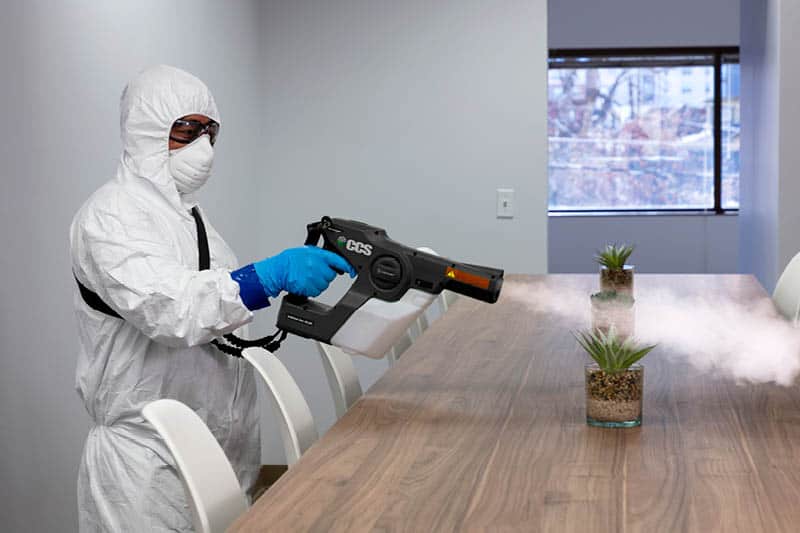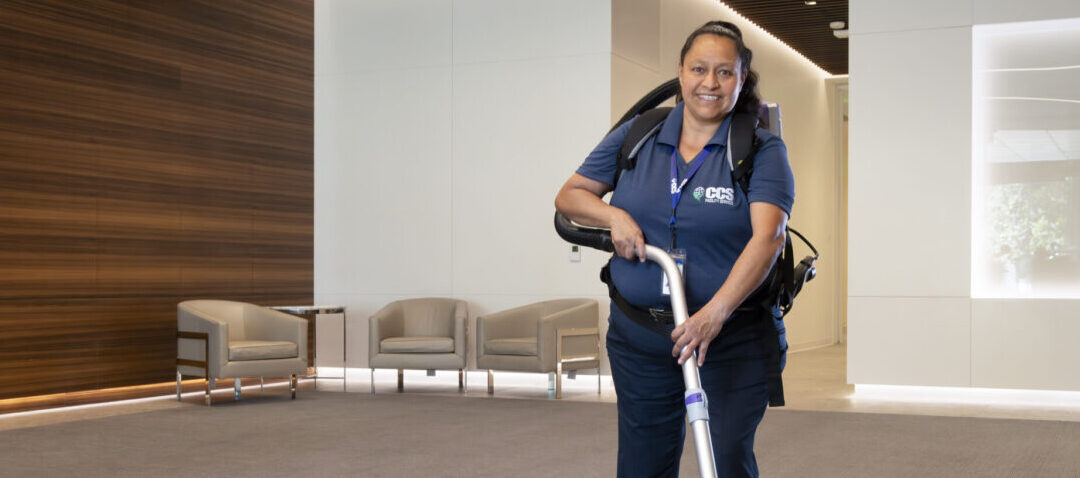The advent of the COVID pandemic brought many new terms into the vernacular. Suddenly, people were talking about viral load and transmissibility and coronavirus – and even learning that the common cold is a type of coronavirus! This new vocabulary also included terms for degrees of cleaning and cleanliness. These may have been terms people had heard, generally speaking, yet still may not truly understand.
When talking about cleaning for health, the key terms to know are: cleaning, sanitizing, disinfecting, and sterilizing. While CCS Facility Services touched on this terminology distinction in our blog post Brushing Up on Infectious Disease Cleaning Best Practices, there is more to understand when it comes to thorough cleaning – especially against infectious diseases — for the safety of building occupants and cleaning crews. This post will go into detail about each of the above cleaning terms, and below is a quick overview of each cleaning method and the relative efficacy in facility cleaning.

Cleaning
Cleaning is often the first step to fighting germs as this is the process to remove dirt, food, dust, and other visible substances from an area. Unlike the other methods discussed below, the results of cleaning are visible in real-time. Dirt and grime are visible to the naked eye, unlike viruses and other small harmful particles that must be targeted with deeper cleaning methods. The Centers for Disease Control and Prevention (CDC) explain “cleaning works by using soap (or detergent) and water to physically remove germs from surfaces. This process does not necessarily kill germs, but by removing them, it lowers their numbers and the risk of spreading infection.” After an area has been cleaned, it is ready for more advanced processes: sanitization, disinfection, and/or sterilization.
Sanitizing
Sanitizer is a chemical-based cleaning agent used to kill bacteria on surfaces. In commercial cleaning, sanitizing often is used in healthcare settings and food preparation areas where there is a need for shorter product dwell time. Sanitizers work almost immediately, making them the preferred choice for a faster clean. For personal use, sanitizer often is found in pocket-sized packaging for individual application or available in an open area for public use. While hand sanitizer is popular for its convenience, hand washing with soap and water remains the superior cleaning practice for preventing the spread of disease. The CDC provides guidance on when it is appropriate to hand wash versus using sanitizer, and CCS Facility Services discusses this in-depth in our blog The Difference Between Hand Washing & Hand Sanitizing.
Disinfecting
Disinfecting can be considered an escalated form of sanitizing. A janitorial team typically chooses to disinfect a space when there’s a chance of exposure to harmful bacteria and bodily fluids. Disinfectant, according to the standards of the United States Environmental Protection Agency (EPA), must kill 99.99% of germs on an applied surface. While the difference is minimal, sanitizer is only required to kill 99.9% of bacteria and tends to have smaller concentrations of bleach in its chemical makeup.

Implementation of disinfection can happen a few different ways, with the more popular option being electrostatic cleaning. This process is explained in depth in CCS’ blog post Understanding Electrostatic Cleaning. There are three main tools cleaning teams can use to conduct electrostatic disinfection: sprayers, foggers, and vaporizers.
Unlike sanitizer, disinfectant needs more time on a surface before it reaches full efficacy. Bathrooms and other high-touch areas benefit from disinfection at the end of a workday, allowing enough undisturbed dwell time for the product to take maximum effect
While disinfecting is a powerful cleaning strategy, careful usage is important to avoid creating “superbugs,” which manifest as a direct result of too much disinfection in an area. Superbugs become antibiotic-resistant through repeated exposure to disinfectant and can be very challenging to remove from a facility once infested. They usually can be found in healthcare and food distribution facilities. They also can contaminate water and soil. According to the Mayo Clinic, superbugs cause urinary tract infections, skin infections, and pneumonia, among other illnesses. The best way to prevent these harmful bacteria from spreading is by carefully following usage directions for disinfectants and adhering to the guidelines from the EPA when using chemical cleaning products. CCS’ blog post Deciphering Cleaning Product Labels provides helpful information on how to best understand directions for product use, storage, and disposal.
Sterilizing
The most effective cleaning method for the removal of harmful microbes and viruses is sterilization. When a surface is sterilized, 100% of the microorganisms on that area are killed. This method is used daily in healthcare settings with medical tools and reusable fabrics needing recurrent sterilization to avoid spreading disease from patient to patient. The types of sterilization vary depending on the object or surface being cleaned. Forms of sterilization methods can include using liquid agents, gas, or steam. The CDC has published a detailed breakdown of each method and precautions to take when integrating sterilization into your facility’s cleaning routine. Due to the dangers associated with sterilization, it is absolutely necessary to employ a professional company that is certified to execute sterilization safely.
A Healthy Clean
Introducing these cleaning methods to your facility’s regular cleaning protocol ensures that building occupants and janitorial crews experience a safe and healthy environment. These four methods have an array of uses that can mitigate the spread of harmful microbes and bacteria if used correctly. The key is to understand the purposes of these cleaning agents and strictly follow the pre-established directions of use designed to protect user health and safety. As pioneers of innovative, exceptional commercial cleaning, CCS Facility Services is well versed in properly implementing chemical cleaning methods across a spectrum of buildings. From healthcare to schools to commercial real estate, CCS prides itself on being able to offer custom cleaning solutions. To learn more about partnering with us, request a quote today.



